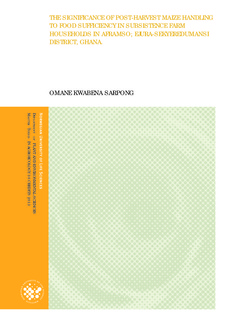| dc.description.abstract | The study concentrated on the role postharvest maize handling in subsistence farm
household’s food sufficiency in Aframso, Ejura-Sekyeredumansi District, located in the
middle belt Ghana. Maize remains an integral crop for subsistence farm households and
plays a vital role in safe guarding food security in the country as a whole. It is the most
widely consumed staple food in the district and Ghana in general, it happens to be the
most important cereal grain in the country. Subsistence farmers in this district are
involved in substantial quantity of maize production in each farming season therefore it
was prudent to undertake this case study to explore the food sufficiency status of the
farmers themselves at the grassroots who are involved with the maize productivity. A
total of sixteen subsistence farmers were interviewed with the aid of an interview guide I
prepared earlier in order to help obtain information regarding the farming and postharvest
activities associated with maize production. In addition, the interview guide was designed to
extract information from other stake holders such as extension service officers and the
director of the ministry of agriculture of the district. Personnel from institutions such as the
Ghana statistical service and council for scientific and industrial research were also contacted
for information. The farmers involved with the study used a normal traditional method of
maize storage, which is the act of storing the harvested maize with the husk on in a
locally constructed cribs as well as using an improved traditional method of storage in
which farmers manually dehusk maize cobs, shell them, bag and pack them on pallets in
well ventilated store rooms in their houses. Various farmers incurred maize losses with
the different types of storage method used but it came to bear that most farmers involved
with the use of the normal traditional storage method experienced food insufficiencies at
different part of the year in both 2011 and 2012, since they incurred higher quantity of
maize loss than farmer who used the improved traditional method. Though the normal
traditional storage method fail to give good protection to the stored maize, farmers are
unable to switch to the improved traditional method because of its easiness to use, the
low cost involved as well as the norms and heritage of the rural subsistence farmers
attached to this method (normal traditional method). | no_NO |
